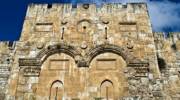
There are more questions than answers when it comes to the mysterious mosaic in the Ein Gedi synagogue, but what we do know is that the secret spice has inspired many writers longing for its sweet fragrance for many centuries.
Having served in the US as a community rabbi before moving to Israel, I really appreciate visits to ancient synagogues. We have uncovered plenty of ancient synagogues all over Israel but perhaps the most intriguing is the one in Ein Gedi.
In the 1960s, while clearing some land for agriculture purposes, an ancient synagogue was found in Ein Gedi, a desert oasis located west of the Dead Sea. Originally built in the beginning of the third century, it continued to function until the 6th century when it was destroyed.
On the floor of the synagogue, there is an interesting Aramaic inscription composed of 18 lines mentioning several different things: First, there is a list of the names of the Patriarchs and elders since creation from Adam to Japheth, thus evoking continuity in mankind. Next, the names of the Patriarchs from Abraham to Jacob appear, evoking the foundations of the Jewish people. Then the mosaic mentions the names of the friends of Daniel: Hananiah, Mishael and Azariah, evoking the end times and messianic revelations in the concealed Book of Daniel.
The mosaic also contains a list of the names of the donors who built the synagogue and then there is a specific and very interesting warning that says roughly: “Woe to those who cause dissension between the community and give the secret of this city to the Gentiles!” Then it adds another line: “The Eye of the Overseer will see and cut off this soul and his seed from the earth!” What does this mean? What secret is forbidden to be divulged by members of the community?
Many scholars believe that the secret of the city was its knowledge of the cultivation of the famous, precious, and very expensive afarsemon: the myrrh. Ever since Ein Gedi was populated, people cultivated this very special plant that yielded the much desired perfume. Nabateans would trade it, Cleopatra wanted it, and the Romans protected the precious industry. Rich people kept it in their treasure chests and robbers would discover it by following its aromatic scent. The Bible mentions this fragrance in the Song of Songs (4:6): “When the day’s cool breeze comes up and the shadows lengthen, I will get myself to the mountain of myrrh to the hill of frankincense”
The secret of this cultivation was lost after the Byzantine era. Today we are cannot definitively identify the plant source of this ancient afarsemon spice. Clearly the secret was well kept.
There are more questions than answers when it comes to the mysterious mosaic in the Ein Gedi synagogue, but what we do know is that the secret afarsemon and its production have inspired many writers longing for its sweet fragrance for many centuries.
The enchanting site of Ein Gedi offers numerous other treasures such as its water sources and Nachal David and Nachal Arugot, which offer wonderful nature walks. The more courageous will discover at the top of the canyon, a chalcolithic temple dating back to 5000 BCE.
Ein Gedi is also identified in the Bible as the place where David fled when he was running from King Saul. The Bible reports: “From there David went up and lived in the strongholds of Ein-Gedi” (II Samuel 23:29).
Ein Gedi is a great place to visit for families. It is a rich, diverse site that offers something for everyone.
By Rabbi Moshe Rothchild, United with Israel
Do You Love Israel? Make a Donation - Show Your Support!
Donate to vital charities that help protect Israeli citizens and inspire millions around the world to support Israel too!
Now more than ever, Israel needs your help to fight and win the war -- including on the battlefield of public opinion.
Antisemitism, anti-Israel bias and boycotts are out of control. Israel's enemies are inciting terror and violence against innocent Israelis and Jews around the world. Help us fight back!






















